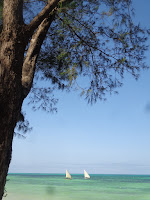I had a specific goal in mind for my second R&R from Kyiv: I wanted to escape the Ukrainian winter for warmer climes. And I went big -- just south of the equator, to the tropical island of Zanzibar. And I was not disappointed. I started sweating the moment I stepped off my plane. Luckily, when I reached Spice Island Hotel & Resort, they had a freshly squeezed watermelon drink ready to refresh me (left). My bungalow had air-conditioning, but at night, I didn't need to use it because the ceiling fan was enough to waft the cool sea breezes over my mosquito-netted bed (right).
Besides enjoying the sunny climate, I set little agenda for myself. Most days, I ate a leisurely breakfast with avocado -- so much avocado -- by the pool (top left). Then I'd set up shop on a lounge chair facing the ocean to relax and read (top right). Occasionally, I jumped in the pool, but mostly I putzed around until dinner, which was surprisingly varied and sometimes sophisticated. One night, the entree choice was local grilled slipper lobster (bottom left). Another night, I made my own pizza: half vegetarian, quarter seafood, and quarter extra cheese (bottom right).My first night, dinner came with entertainment, in the form of a tribe leader playing native music on a range of interesting instruments (top). It was an engaging performance, but I was equally enamored by the range of cocktails on the resort's own dock bar (bottom left). Daily drink specials made good use of local ingredients, such as the melon margarita I drank at dusk (bottom right).
I wasn't entirely a lazy beach bum. Almost every day, I did some sort of activity. One day, the in-house skipper and his recruited assistant took me snorkeling at a nearby sandbar with lots of coral outcroppings (left). I saw lots of colorful fish and some particularly brilliant-red starfish. But possibly even more enjoyable was riding there and back in a traditional dhow, basically a big canoe with a sail (right).
Another day, I set out on foot for the 30-minute walk to Kuza Cave. It was a hot route with little shade, so I was chomping at the bit to climb down the precarious path to the sheltered natural rock formation (top left). Many bowl-like structures can be found around the island, but this is one of the only ones to have water, so it was named after the Swahili word for womb (top right). I joined a couple of Slovakian tourists who arrived around the same time as I for a dip in the crisp spring water (middle left). We were given snorkel masks so we could check out the various stalagmites and crevices underwater (middle right). After a relaxing splash around, we dried off with an impromptu drumming and dancing session (bottom).
On yet another hot day, I went, by car this time, to Jambo Spice Farm (top left). The farm has large fields for mass production, but the surrounding community of workers has turned part of the enterprise into a tourist destination (top right). Upon arrival, I received a leaf cup to collect the remnants of various spices I tasted right off the plant (middle left), including the easily recognizable peppercorn (middle right) and the surprisingly artistic nutmeg seed (bottom).
The farm cultivates crops besides spices, including cacao (top left) and red bananas (top right). After about an hour of wandering through the bushes and trees, we were able to take a load off and were served a wide variety of tropical fruit, including the exotic bananas (bottom left). One worker climbed a tree to cut down coconuts, whose water and fruit we ate directly from the shell. We did so while adorned with crowns and bracelets made from palm leaves and hibiscus flowers (bottom right).
Other days, I kept my adventures closer to home. I rented a big-tire bike from my hotel and rode north along the sand until I got hungry (top left). Then I returned to Paje for lunch: fresh fruit juice with a mango and avocado -- yes, more avocado -- salad from Mr. Kahawa (top right). The coastline is dotted with tourist trappings, but the presence of locals, including some schoolchildren playing a recess game, was a welcome reminder that the island is not just a resort (bottom left). While some vacationers tried their hand at kite surfing, the villagers plied their trade of harvesting seaweed (bottom right).To the south of my hotel, in Jambiani, fishermen sort their catch and dry their haul at the local seaweed center (top left). The tides are drastic, so they have to cross expanses of rock- and coral-laden sands to reach their tethered dhows (top right). Although some buildings in the village are crumbling, the community of fisherman continues to thrive as it transitions to a more tourism-oriented economy (bottom).
When I saw a sign for Kim's Restaurant on the beach, I couldn't not check it out (top left). I was the only customer at the thatched-roof outdoor eatery, where they were constructing some adjacent hotel rooms (top right). The builders seemed happy for an excuse to take a break. One scurried up a nearby tree and knocked down coconuts for them to drink and for the cook to use in my order of coconut-crusted fish (bottom left). They even gave me one to enjoy alongside my Safari Lager as I waited for my meal (bottom right).




































No comments:
Post a Comment